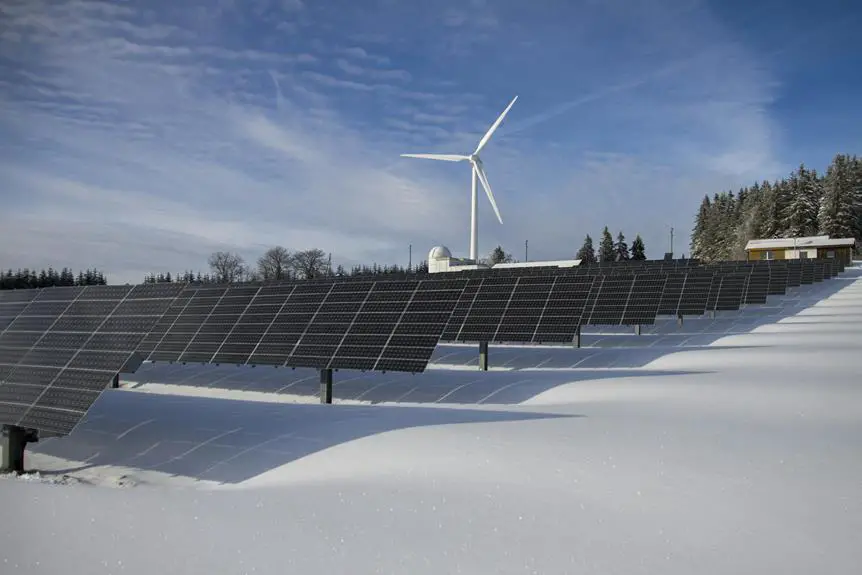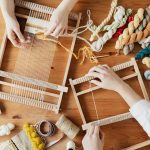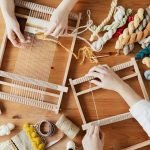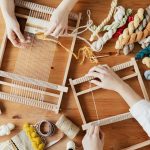When you consider Jacquard production, it's crucial to recognize its environmental implications, particularly regarding water and energy consumption. You might be surprised to learn how the choice of raw materials, like organic cotton, can influence sustainability. Yet, the dyeing process and resulting waste present significant hurdles that can't be overlooked. Exploring the eco-friendly practices and innovations that could reshape this industry leads to a compelling question: can the Jacquard sector truly balance creativity and sustainability in a way that benefits both the planet and its artisans?
Table of Contents
Overview of Jacquard Production
Jacquard production involves weaving intricate patterns using a specialized loom that automates the process, making it both efficient and versatile. You'll notice that this technology allows for complex designs to be crafted with precision, replacing traditional methods that required more manual labor. The Jacquard loom uses a series of punched cards to control the lifting of threads, which means you can create patterns without needing to manually adjust each thread.
As you delve into Jacquard production, you'll appreciate the craftsmanship involved. Each loom can produce a variety of designs, from simple motifs to elaborate scenes, giving you the freedom to explore creativity while maintaining consistency. The automation reduces the time needed for production, enabling you to respond quickly to market demands.
Moreover, the integration of technology into weaving has revolutionized the textile industry, allowing for unique fabric applications across fashion, upholstery, and interior design. You'll find that this efficiency not only enhances productivity but also opens doors for sustainable practices, as less material is wasted during the production process.
Jacquard production truly represents a blend of artistry and innovation that continues to evolve.
Sourcing Raw Materials
When you consider sourcing raw materials for Jacquard production, it's crucial to think about sustainable fiber options.
You'll also want to pay attention to water consumption concerns, as these factors significantly impact the environment.
Making informed choices here can lead to a more eco-friendly production process.
Sustainable Fiber Options
Sourcing sustainable fibers is crucial for reducing the environmental footprint of textile production. When you choose fibers like organic cotton, Tencel, or hemp, you're supporting practices that minimize harm to the planet.
Organic cotton, for instance, is grown without harmful pesticides or synthetic fertilizers, making it a healthier option for both the environment and farmers.
Tencel, made from sustainably sourced wood pulp, is produced in a closed-loop process that recycles water and solvents, significantly reducing waste. Hemp is another excellent choice; it requires less water than traditional crops and grows quickly, making it a low-impact option.
You can also explore recycled fibers, which repurpose existing materials, cutting down on the need for virgin resources. By opting for these sustainable alternatives, you're not just choosing eco-friendly materials; you're advocating for responsible sourcing practices that support ethical labor and environmental stewardship.
When you make informed decisions about the fibers you use, you contribute to a more sustainable textile industry. Ultimately, your choices can help drive demand for sustainable practices, paving the way for a greener future in Jacquard production and beyond.
Water Consumption Concerns
Water consumption in textile production raises significant concerns, particularly with the demand for raw materials that often strain local resources. When you consider the sourcing of fibers like cotton and wool, it's clear that the water footprint can be staggering. Cotton, for instance, requires massive amounts of water, often leading to depletion of nearby rivers and aquifers. If you're involved in the production process, you need to be aware of how sourcing these materials impacts the environment.
Moreover, regions heavily reliant on water-intensive crops face droughts and water scarcity, which can lead to social and economic strife. If you choose to work with these materials, it's crucial to evaluate the sustainability of your sourcing practices. Opting for organic cotton or recycled fibers can significantly reduce the water consumption associated with your products.
You might also consider collaborating with suppliers who prioritize water-efficient farming methods. By doing so, you can contribute to a more sustainable textile industry. Understanding the water consumption concerns related to raw material sourcing helps you make informed decisions that benefit both your business and the environment.
Water Usage in Production
In the production of Jacquard fabrics, significant amounts of water are consumed, raising concerns about sustainability. You mightn't realize it, but water plays a crucial role throughout the entire process, from dyeing the fabrics to cleaning the machinery. Each step requires careful management of water resources, as excessive use can lead to detrimental environmental effects.
During dyeing, large volumes of water are needed to ensure vibrant colors and proper fixation. If not managed responsibly, this can lead to water wastage and pollution, especially if harmful chemicals are involved. Additionally, the cleaning processes for equipment and fabrics also consume substantial water, further compounding the issue.
As a consumer, you can help by choosing Jacquard fabrics produced with sustainable methods that prioritize water conservation. Look for brands that utilize closed-loop systems or innovative technologies designed to minimize water usage.
Energy Consumption Concerns
Jacquard production is energy-intensive, requiring significant electricity and fuel to power weaving machines and dyeing processes. This high energy demand raises concerns about the environmental impact, particularly in regions where fossil fuels dominate the energy mix. You mightn't realize that the carbon footprint associated with Jacquard textiles can be substantial, especially when you consider the entire production cycle.
As a consumer, you should be aware that energy consumption doesn't just affect the manufacturers; it also contributes to climate change and resource depletion. When you choose Jacquard fabrics, consider the energy sources involved in their production. Brands committed to sustainability often invest in renewable energy solutions, which can help mitigate these concerns.
Additionally, opting for locally produced Jacquard fabrics can reduce transportation energy costs, further lowering the overall environmental impact. It's valuable to seek out certifications or labels that indicate responsible energy use in the production process.
Chemical Treatments and Dyes
While producing Jacquard textiles, manufacturers often rely on chemical treatments and dyes that can pose significant environmental risks. These chemicals, used to enhance colors and improve fabric durability, frequently contain harmful substances like heavy metals and formaldehyde. You mightn't realize it, but these toxins can leach into water systems, harming aquatic life and contaminating drinking water sources.
Moreover, the dyeing process itself can consume large amounts of water, further straining local resources. When you consider that many of these chemicals aren't biodegradable, the long-term impact becomes even more concerning. The synthetic dyes commonly used can persist in the environment for years, creating a legacy of pollution.
Fortunately, some manufacturers are beginning to adopt more sustainable practices. By using natural dyes or eco-friendly chemical treatments, they can significantly reduce their environmental footprint.
As a consumer, you can support these efforts by choosing Jacquard textiles that prioritize sustainable production methods. By making informed choices, you not only help protect the environment but also encourage more manufacturers to shift towards greener alternatives, ultimately benefiting the planet as a whole.
Waste Generation and Disposal
The production of Jacquard textiles generates considerable waste, including off-cuts, defective items, and leftover dyes, all of which present significant disposal challenges. You mightn't realize it, but these materials can contribute to landfill overflow if not managed properly. Off-cuts, for example, often end up discarded, taking up space and potentially leaching harmful chemicals into the environment.
Defective items, which can arise from manufacturing errors, pose another issue. If not reused or recycled, they increase waste and add to the industry's carbon footprint. Leftover dyes, particularly those containing toxic substances, require careful handling. Improper disposal can lead to soil and water contamination, affecting local ecosystems and communities.
To tackle these challenges, many producers should consider implementing waste reduction strategies. This can include reusing off-cuts for smaller products or finding innovative ways to recycle defective items. Additionally, managing dye waste through proper treatment methods can minimize environmental harm.
The choices you make in waste disposal directly impact the sustainability of Jacquard production, so it's crucial to prioritize responsible practices and consider the long-term effects of your actions.
Sustainable Alternatives and Innovations
When you consider sustainable alternatives in Jacquard production, think about using eco-friendly materials that minimize environmental harm.
You can also explore energy-efficient production techniques that reduce energy consumption, alongside waste reduction strategies that limit excess.
Together, these innovations can significantly lower the ecological footprint of your textile practices.
Eco-Friendly Materials Usage
Exploring eco-friendly materials in Jacquard production opens up innovative avenues for sustainability and reduces environmental impact. You can make a significant difference by opting for materials that aren't only stylish but also environmentally friendly.
Here are three choices to consider:
- Organic Cotton: Grown without synthetic pesticides or fertilizers, organic cotton offers a biodegradable and sustainable alternative to conventional cotton. It's soft, durable, and great for producing high-quality Jacquard fabrics.
- Recycled Polyester: Made from recycled plastic bottles and other post-consumer waste, recycled polyester helps reduce landfill waste and energy consumption. By choosing this material, you contribute to a circular economy while enjoying the benefits of lightweight and moisture-wicking fabrics.
- Bamboo Fibers: Bamboo is a fast-growing, renewable resource that requires minimal water and no pesticides. Its fibers are naturally antibacterial and biodegradable, making it a fantastic choice for eco-conscious Jacquard production.
Energy-Efficient Production Techniques
Implementing energy-efficient production techniques can significantly reduce the carbon footprint of Jacquard manufacturing while enhancing overall sustainability. You can start by investing in advanced machinery designed to consume less energy. High-efficiency looms and automated systems not only lower energy usage but also improve production speed and precision.
Consider adopting renewable energy sources, such as solar or wind power, for your manufacturing facilities. By harnessing clean energy, you'll decrease reliance on fossil fuels, further minimizing your environmental impact. Additionally, improving insulation and optimizing heating and cooling systems can lead to substantial energy savings.
Another key approach is to streamline your production processes. By analyzing workflow and eliminating bottlenecks, you can enhance efficiency and reduce energy waste. Implementing smart technology, like IoT sensors, allows real-time monitoring of energy consumption, enabling you to make adjustments as needed.
Lastly, training your staff on energy-efficient practices fosters a culture of sustainability within your organization. By prioritizing energy-efficient production techniques, you're not only taking a stand for the environment but also improving your bottom line through reduced operational costs.
Waste Reduction Strategies
Adopting waste reduction strategies is essential for enhancing sustainability in Jacquard production and can lead to significant environmental benefits. By implementing these strategies, you can minimize resource use, lower costs, and reduce your ecological footprint.
Here are three effective waste reduction strategies to consider:
- Material Optimization: Evaluate your patterns and designs to maximize fabric usage. Adjusting the layout can significantly reduce scrap material.
- Recycling and Upcycling: Instead of discarding leftover materials, find ways to recycle or upcycle them into new products. This not only reduces waste but can also create unique offerings for your customers.
- Digital Sampling: Utilize digital tools to create virtual samples instead of physical ones. This reduces the need for material, cutting down on waste while still allowing for design experimentation.
Frequently Asked Questions
How Does Jacquard Production Compare to Other Textile Manufacturing Processes Environmentally?
When you compare jacquard production to other textile processes, you'll notice it often uses less energy and water. However, its environmental impact varies based on materials and methods, so it's essential to consider all factors.
What Are the Long-Term Effects of Jacquard Waste on Ecosystems?
You'll find that jacquard waste can lead to soil degradation, disrupt water quality, and harm local wildlife. Over time, these effects accumulate, threatening biodiversity and altering ecosystems, which ultimately impacts the balance of your environment.
Are There Certifications for Sustainable Jacquard Production?
Yes, there are certifications for sustainable jacquard production. You can look for labels like Global Organic Textile Standard (GOTS) or OEKO-TEX, which ensure responsible practices and materials, promoting eco-friendliness in textiles you choose.
How Can Consumers Identify Eco-Friendly Jacquard Products?
To identify eco-friendly jacquard products, look for certifications like GOTS or OEKO-TEX. Check for sustainable materials, transparency in sourcing, and brands committed to ethical practices. Reading labels and researching brands can help you make informed choices.
What Role Does Consumer Demand Play in Sustainable Jacquard Production?
Consumer demand drives sustainable jacquard production by pushing brands to prioritize eco-friendly practices. When you choose sustainable options, you encourage manufacturers to adopt greener methods, ultimately shaping the industry towards more responsible production and consumption.
- How Does Ring Spun Cotton Affect Garment Fit and Shape Retention? - August 13, 2024
- What Are the Challenges in Producing Ring Spun Cotton? - August 13, 2024
- Is Ring Spun Cotton Suitable for Plus-Size Clothing? - August 13, 2024






